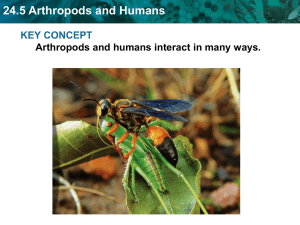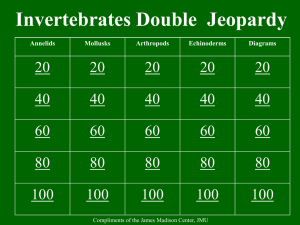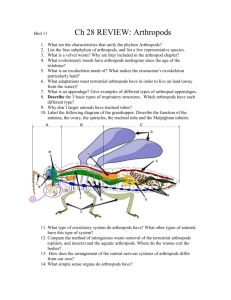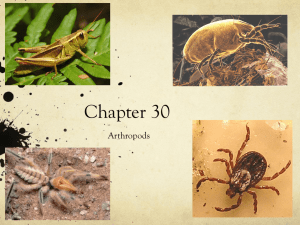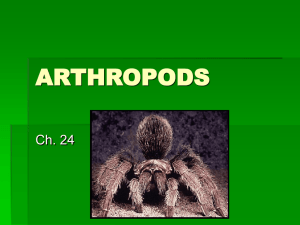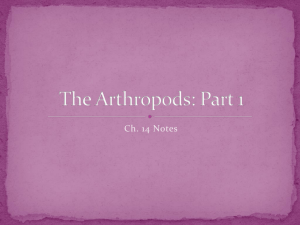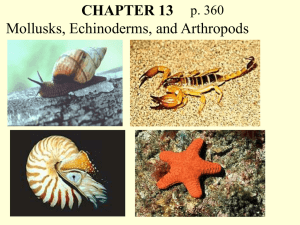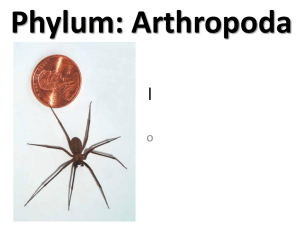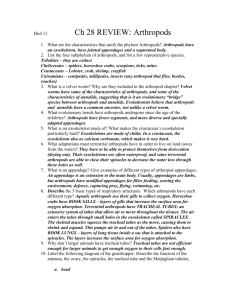Arthropods Notes
advertisement
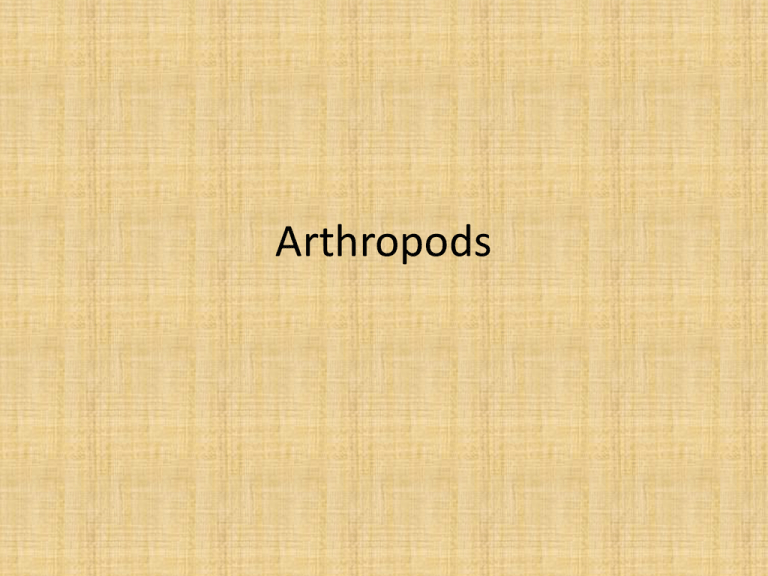
Arthropods Characteristics • Between 70-85% of all names species are Arthropods • The majority of arthropods are insects • Segmented invertebrates with bilateral symmetry and a coelom body cavity Segmentation • Arthropods exoskeleton is broken into 2-3 segments – Head – Thorax – Abdomen • Head is for feeding and multiple types of eyes Segmentation • Thorax is the middle body region, in many arthropods legs or wings are attached. • Abdomen is the posterior end which has additional legs and contains digestive and reproductive structures Segmentation • Cephalothorax- is where the head and thorax are fused together into one piece Exoskeleton • Arthropods have an exoskeleton made out of chitin • The thickness and hardness of the exoskeleton can vary among species Jointed appendages • Arthropods have paired appendages • Appendages are structures such as legs and antennae, that grow and extend from the animals body Molting • Because the exoskeleton is made out of nonliving material it can not grow so they must shed it. • The process of shedding the exoskeleton is called molting Body structure • Arthropods have complex organs systems that enable them to live in diverse habitats – Respiratory – Circulatory – Excretory – Nervous Feeding and digestion • The mouthparts of most arthropods include a pair of appendages called mandibles that can bite and chew material • They have a complex one way digestive tract Respiration • Arthropods obtain oxygen by using one the three following structures – Gills (aquatic arthropods have these- lobsters) – Tracheal tubes – Book lungs Respiration • Gills – water moves over gills – O2 from water diffuses into gills and into bloodstream – CO2 from body diffuses out through gills into surrounding water Respiration • Tracheal tubes – branching network of hollow air passages that take air throughout the body Muscle movement brings air in/out through SPIRACLES (openings in abdomen and thorax) Respiration • Book lungs – spiders and relatives – air filled chambers with leaf-like plates – stacked plates are arranged like pages of a book Circulation/excretion • Most arthropods don’t rely on their circulatory system to move oxygen but to move nutrients and waste • Cellular waste is removed from the blood through malpighian tubules Response to stimuli • Vision- Most arthropod have compound eyes that have many facets • Hearing- Tympanum is a flat membrane used for hearing Response to stimuli • Chemicals- many insects use pheromones to communicate with one another. Movement/reproduction • Insects have well developed muscular systems – Some insects can carry 50 times their own body weight • Most reproduce sexually and have individual sexes some are hermaphrodites Antennae • Acute sensing by antennae – stalk like structure that can detect changes in the environment • movement • sound • chemicals Used for sound and odor communication Eyes • Compound Eyes – visual structure with many lenses • Simple Eyes – visual structure with one lens for detecting light one pair of compound eyes and 3-8 simple eyes Nervous System • Double ventral nerve cord • Anterior brain • Several fused ganglia that control the body section they are located in Circulatory System • Open circulatory system – blood flows away from the heart in vessels – blood flows out of vessels into tissues – blood returns to the heart through open spaces Digestive System • Complete digestive system with mouth, intestine, and anus • Mouth has 1 pair of jaws called MANDIBLES – adapted for holding, chewing, sucking, or biting Reproduction – Sexual and Asexual • Sexual reproduction – separate sexes – internal fertilization for terrestrial species – external fertilization for aquatic species Reproduction – Sexual and Asexual • Asexual reproduction – PARTHENOGENISIS • a new individual develops from an unfertilized egg • seen with ants, aphids and bees Arachnids • spiders (largest group), ticks, mites, and scorpions • 2 body regions: cephalothorax and abdomen • 6 pairs of jointed appendages – 12 total appendages! Arachnids • 1st pair - chelicerae, are near the mouth chelicerae • modified into pincers (hold food) or fangs (inject poison) Arachnids • 2nd pair – pedipalps, for handling food and sensing pedipalps Arachnids • Silk, for webs, is secreted by silk glands in the abdomen • as it is secreted, it is spun into thread by SPINNERETTES • spiders are predatory and feed almost exclusively on other animals Arachnids • Ticks and mites have only 1 body section • Head, thorax and abdomen are completely fused • Ticks feed on blood of other animals Arachnids • Mites feed on fungi, plants, and animals • small – not usually visible • can transmit diseases Dust mites Arachnids • Scorpions have many abdominal body segments • Enlarged pincers • Long tail with venomous stinger at the tip Crustaceans • crabs, lobster, shrimp, crayfish, barnacles • Only arthropods with 2 pairs of antennae • mandibles – move from side to side • 2 compound eyes Crustaceans • 5 pairs of walking legs • 1st pair are claws for defense claw legs Crustaceans • Most are aquatic and use gills • pill bugs (roly-polies) live on land, but must have moisture to aid in gas exchange Yes! This is a crustacean! Centipedes and Millipedes • Centipedes are carnivorous – eat soil arthropods, snails, slugs, and worms • Bites can be painful • Millipedes – eats plants and dead material on damp forest floors • Does not bite, but does spray foul-smelling fluid Horseshoe Crabs • Class Merostomata • “Living Fossils”- unchanged for 220 million years (Triassic period) • Extensive exoskeleton • Live in deep coastal waters • forage bottoms for algae, annelids and molluscs Insecta • • • • Flies, grasshoppers, lice, butterflies, beetles 3 body segments 6 legs Very diverse - more insects than all other classes of animals combined Insecta • mate once in lifetime • internal fertilization • some exhibit parthenogenesis • large number of eggs to increase survival rate Insecta Nymph Molt Eggs Nymph Molt Adult • insect embryos develop inside eggs, eggs hatch • some look like miniature adults – will molt several times until adult size Insecta • INCOMPLETE METAMORPHOSIS – 3 stages: egg, nymph, adult • Nymphs can’t reproduce • Nymph gradually becomes an adult Insecta • Some undergo COMPLETE METAMORPHOSIS Adult Egg – 4 stages: egg, larva, pupa, adult • Metamorphosis is controlled by chemical substances in the insect Larva Pupa Insecta • Incomplete metamorphosis: grasshoppers and cockroaches • Complete metamorphosis: ants, beetles, flies, wasps Origins of Arthropods • Successful because of – varied life styles – high reproductive output – structural adaptations – hard exoskeletons – jointed appendages Origins of Arthropods • Hard exoskeletons fossilize – a lot is known about evolutionary history • Evolved from ANNELIDS (segmented worms) • Arthropods have more complex segments, more developed nervous systems • circular muscles in annelids do not exist in arthropods

